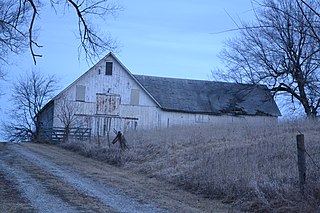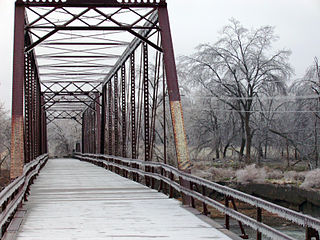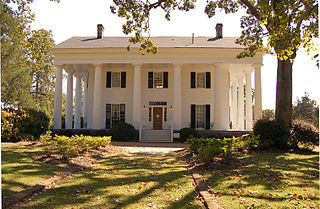
First Landing State Park offers recreational opportunities at Cape Henry in the independent city of Virginia Beach, Virginia. As the first planned state park of Virginia, First Landing is listed on the National Register of Historic Places as Seashore State Park Historic District. A portion of the park is listed as a National Natural Landmark as part of the Seashore Natural Area.

Scenic State Park is a Minnesota state park near Bigfork in Itasca County. It encompasses 3,936 acres (1,593 ha) of virgin pine forests that surround Coon and Sandwick Lakes. It also includes portions of Lake of the Isles, Tell Lake, Cedar Lake and Pine Lake. Established in 1921, the Ojibwe tribe had previously used the area for hunting. The park has places for camping, hiking, swimming, fishing, and canoeing.

The Lake McDonald Lodge Historic District is a historic district in Glacier National Park in the U.S. state of Montana. It comprises the Lake McDonald Lodge and surrounding structures on the shores of Lake McDonald. It is centered on the main lodge, which was designated a National Historic Landmark in 1987, as well as surrounding guest cabins, dormitory buildings, employee residences, utility buildings, and retail structures. The district includes several privately owned inholding structures that are contributing structures, as well as a number of non-contributing buildings.

Watoga State Park is the largest of West Virginia's state parks, covering slightly over 10,100 acres (41 km2). It is located near Seebert in Pocahontas County, West Virginia.

Roaring River State Park is a public recreation area covering of 4,294 acres (1,738 ha) eight miles (13 km) south of Cassville in Barry County, Missouri. The state park offers trout fishing on the Roaring River, hiking on seven different trails, and the seasonally open Ozark Chinquapin Nature Center.

Cabin Branch Pyrite Mine Historic District is a national historic district located at Prince William Forest Park, Triangle, Prince William County, Virginia. It encompasses 4 contributing sites and 42 contributing structures associated with the Cabin Branch pyrite mine. The pyrite mine opened in 1889, and remained in operation until 1919 or 1920. The property includes a number of capped mine shafts, and the remains of a commissary building and an old mill; and mine structures, including crusher house, mill, mechanical and support buildings, numerous rail lines.

Boxwood Lodge is a historic hunting retreat and national historic district located near Mocksville, Davie County, North Carolina. The district encompasses 8 contributing buildings, 1 contributing site, and 4 contributing structures on a rural estate including a manor house. It was developed between 1911 and 1931 by William Rabb Craig (1870-1931), a wealthy cotton and sugar broker. The manor house was built between 1933 and 1934, and is a two-story, "H"-plan, brick Colonial Revival dwelling designed by the architectural firm Delano & Aldrich. Other notable resources include the grounds of Boxwood Lodge, greenhouse, log cabin, great barn (1910s), feed / grain house, and entrance piers (1934).

Jones–Johnson–Ballentine Historic District is a national historic district located near Fuquay-Varina, Wake County, North Carolina. The district encompasses 18 contributing buildings, 3 contributing sites, and 8 contributing structures on the Johnson Farm and the Ballentine Farm near Fuquay-Varina. The district includes notable examples of Classical Revival and Victorian style architecture. Notable resources include the William Wesley Johnson House, The Log Cabin, James E. Ballentine House (1890), The Creamery, Dairy Barn (1915), a family cemetery and the surrounding farm landscape.

Walnut Park Farm Historic District, also known as the R.L. McDonald Farm, Country Club Farm, Creek Farm, and Schreiber Farm, is a historic farm and national historic district near St. Joseph, Andrew County, Missouri. The district encompasses four contributing buildings, one contributing site, and one contributing structure on a livestock breeding farm near St. Joseph. It developed between about 1870 and 1914, and includes a brick, 1 1⁄2-story gabled ell residence, an L-form basement barn, a stable, root cellar, and the site of an enclosed track and show ring where the farm's purebred horses were trained and shown to prospective buyers. The brick residence has since been demolished.

Big Spring Historic District is a national historic district located at Van Buren, Carter County, Missouri. It encompasses 26 contributing buildings, 1 contributing site, and contributing structure in the Ozark National Scenic Riverways. It includes the Big Spring, rental cabins, service building, storage shed, garage, a museum, dining lodge, restroom, shelter house, ranger station, pump house, footbridge, and two picnic shelters. The structures represent the best features of park construction by the Civilian Conservation Corps in Missouri.

Watkins Family Farm Historic District, also known as Lakeland Farm, is a historic home and farm and national historic district located near Raymore, Cass County, Missouri. The farm includes 18 contributing buildings, three contributing sites, and 21 contributing structures dated between about 1868 and 1957. They include three residential buildings, eight barns, three machine and implement sheds, four wells, ten dams and ponds, and a number of ancillary structures such as a milk house, a pump house, an outhouse, a silo, two corn bins, two chicken coops, three cattle feeder structures, and a cattle loading ramp. The Allen-Watkins Residence was built in 1913, and is a 2 1/2-story, Prairie School style frame dwelling built from the Sears and Roebuck Company prefabricated kit for Sears House Plan #227, "The Castleton."

Caplinger Mills Historic District is a national historic district located at Caplinger Mills, Cedar County, Missouri. The district includes one contributing site and three contributing structure related to the development and use of water power in Cedar County. It developed between about 1895 and 1943, and includes a grist mill site, dam, power house and double span Pratt with two pony truss approach spans bridge (1895).

Moreau Park Historic District is a national historic district located near Jefferson City, Cole County, Missouri. It encompasses seven contributing buildings, one contributing site, and five contributing structures associated with a former resort along the Moreau River near Jefferson City. The district developed between about 1914 and 1950, and includes some historic landscaping features, the native stone Dallmeyer House, Moreau Lodge (1914), one remaining guest cabin, two stone outbuildings, a privy, barn, and concession stand.

Rock Fountain Court Historic District, also known as Melinda Court, is a historic traveler's accommodation and national historic district located at Springfield, Greene County, Missouri. The district encompasses 10 contributing buildings and 1 contributing structure associated with a tourist court. The district developed between about 1945 and 1952, and includes 9 tourist cabins and a large frame garage. The cabins are of frame construction and faced in masonry ranging from all dark sandstone, to white limestone accented with red brick.

John A. Adams Farmstead Historic District, also known as Cedarcroft Farm, is a historic home and farm and national historic district located near Warrensburg, Johnson County, Missouri. The district consists of four contributing properties --three contributing buildings and one contributing structure. The buildings are a house, a barn, and a barn. The structure is a system of sewer and drainage tiles and dams constructed beginning in 1875 and which underlays much of the district.

North Third Street Historic District is a national historic district located at Louisiana, Pike County, Missouri. The district encompasses 61 contributing buildings, 1 contributing site, and contributing structure in a predominantly residential section of Louisiana. It developed between about 1843 and 1935, and includes representative examples of Greek Revival, Gothic Revival, Italianate, Queen Anne, Colonial Revival, and Bungalow / American Craftsman style architecture. Located in the district are the separately listed Louisiana Public Library and Luce-Dyer House. Other notable buildings include the William C. Hardin House, James H. Johnson House, Edward G. McQuie House, St. Joseph's Catholic Church (1874), and Frank Boehm, Jr. House.

Isiah Mansur Farmstead Historic District, also known as Rock Hall, is a historic home and farm and national historic district located near Richmond, Ray County, Missouri. The district encompasses eight contributing buildings, one contributing site, and three contributing structures on a farm developed between the mid-19th and mid-20th centuries. The contributing resources include the main farmhouse, a buggy house, a large barn, an engine house (c.1900), a small barn, a brooder house, a hen house, a smokehouse, a house well, a field well, and a wellhouse. The main farmhouse is a two-story, five bay, frame I-house.

Alton Club, also known as the Jerry J. Presley Conservation Education Center, is a historic summer camp and national historic district located in the Current River State Park near Eminence, Shannon County, Missouri. The district encompasses 14 contributing buildings, 3 contributing sites, and 6 contributing structures associated with a summer retreat for the employees and customers of the Alton Box Board Company. It developed between about 1937 and 1945 and include the Main Lodge, Clasroom / Pool Hall, Lower Dorm, Gymnasium, Barbeque House, Lake House, Manager's Residence, and Entrance Columns.

Walter Klepzig Mill and Farm is a historic farm and sawmill and national historic district located in the Ozark National Scenic Riverways near Eminence, Shannon County, Missouri. The district encompasses three contributing buildings, three contributing sites, and one contributing structure associated with an early-20th century Ozark farm and mill. It developed between about 1912 and 1936 and includes the mill and its related hydraulic system ; a spring house and smokehouse ; foundations of a 1923 farmhouse and barn ; and two post-1934 chicken coops and a ruin of a post-1934 machine shed.

Prairie View Stock Farm, also known as the Bluestem Ranch, is a historic farm and national historic district located near Rich Hill in Bates County and Vernon County, Missouri. The district encompasses four contributing buildings, three contributing sites, and two contributing structures in a Rural Historic Landscape District. The contributing sites include a hay meadow, a tall fescue prairie, and a 160-acre plot of native, tall-grass prairie. It is a state designated Prairie View Natural Area. The contributing buildings are a transverse-crib barn/grain house, a barn/feeding facility, a two-story, frame, folk Victorian house (1893-1894), and a frame privy (1893-1894). The contributing structures are a storm cellar (1893-1894) and an arbor.






















